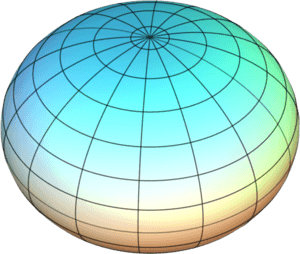Reference ellipsoid facts for kids
A reference ellipsoid is a special kind of ellipsoid (a 3D shape like a squashed ball). Scientists use it as a simple model to understand the shape of the Earth. It's like a smooth, perfect version of our planet.
It's much easier to use a reference ellipsoid for calculations than the real shape of Earth, which is called the geoid. The geoid is more bumpy and uneven because of things like mountains and ocean trenches.
How We Figured Out Earth's Shape
For a long time, people thought the Earth was a perfect sphere (a round ball). This idea came from Ancient Greece. But in the 1600s, scientists started to wonder if this was true.
In 1688, a famous scientist named Isaac Newton showed something important. He used mathematics to explain that because the Earth spins, it should bulge out at the middle (the equator) and be a bit flat at the top and bottom (the poles). Think of it like spinning a soft ball – it flattens a little at the ends. This was different from what another scientist, Giovanni Domenico Cassini, thought.
About 50 years later, Newton's idea was proven right. Two French scientists, Pierre Bouguer and Alexis-Claude Clairaut, went on long trips. They traveled to Peru (near the equator) and Lapland (near the North Pole) between 1735 and 1741.
They measured distances on Earth very carefully. Their measurements showed that the Earth is indeed flatter at the poles, just as Newton had predicted.
Defining the Metre
The measurements from these trips also helped define the metre. In 1791, the metre was first set as one ten-millionth (1/10,000,000) of the distance from the North Pole to the equator. This was an ideal distance, based on the Earth's shape.
However, there were small mistakes in the early measurements. So, the definition of the metre was adjusted a couple of times. The definition from 1799 is still the official one, even though we now know it was slightly off.
Later, in 1983, the metre was redefined again. This time, it was based on how far light travels in a specific amount of time when it's in a vacuum (empty space). This new definition is much more precise.
See also
 In Spanish: Elipsoide de referencia para niños
In Spanish: Elipsoide de referencia para niños


